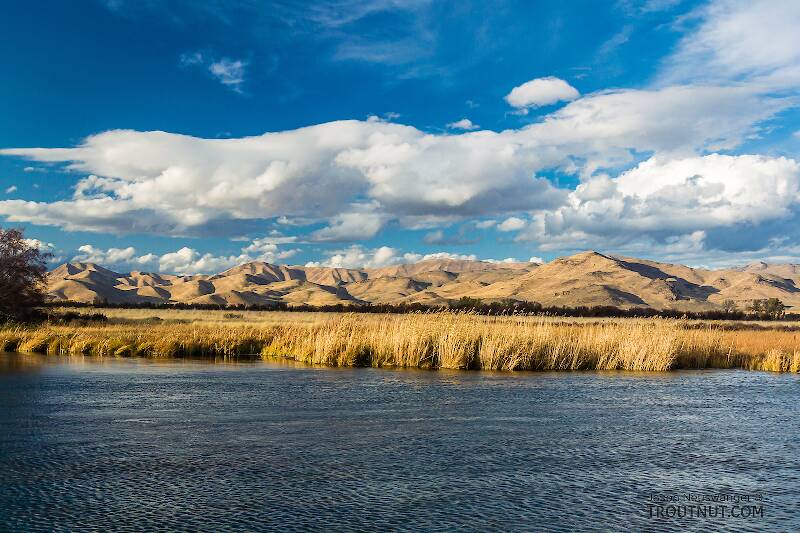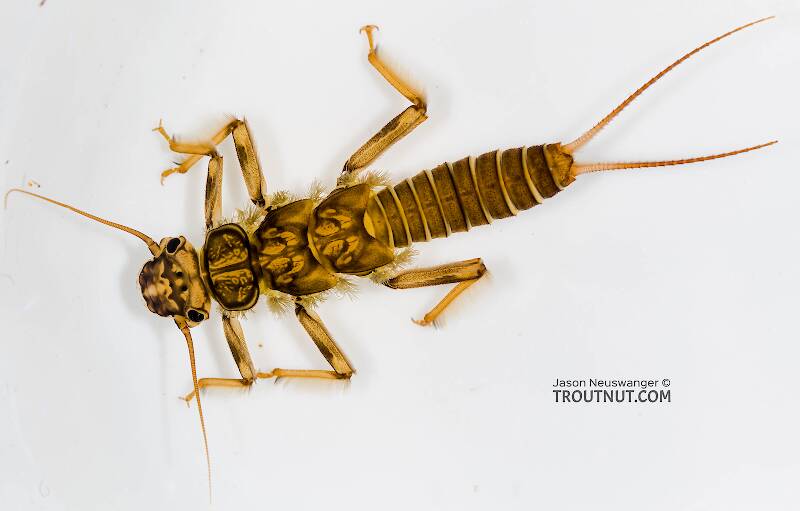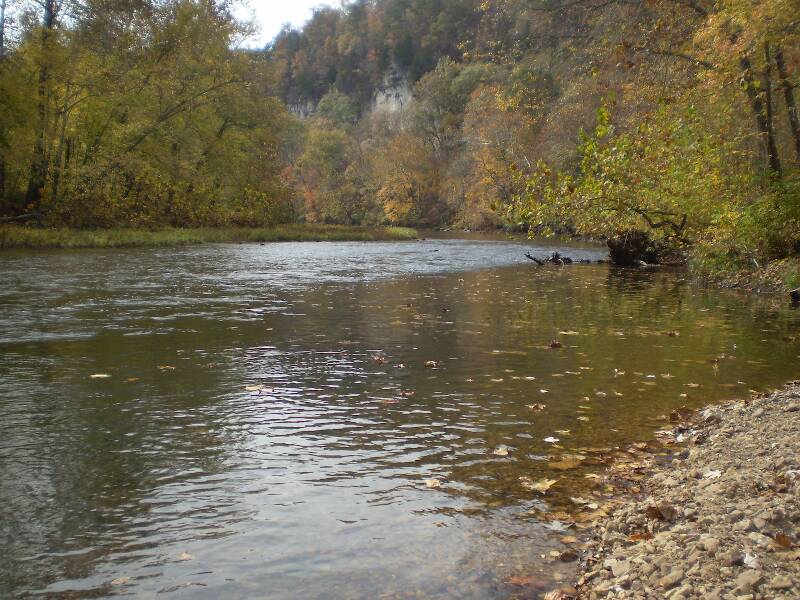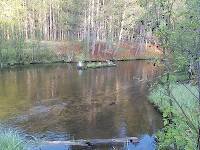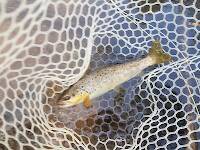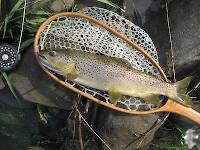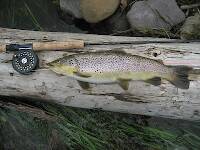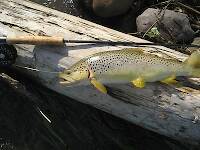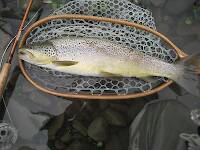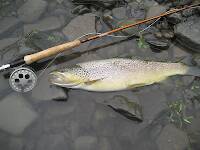
Blue-winged Olives
Baetis
Tiny Baetis mayflies are perhaps the most commonly encountered and imitated by anglers on all American trout streams due to their great abundance, widespread distribution, and trout-friendly emergence habits.
Featured on the forum

Troutnut is a project started in 2003 by salmonid ecologist Jason "Troutnut" Neuswanger to help anglers and
fly tyers unabashedly embrace the entomological side of the sport. Learn more about Troutnut or
support the project for an enhanced experience here.
Report at a Glance
| General Region | Colorado |
| Specific Location | 9000ft |
| Dates Fished | 8/8 + 8/17 |
| Time of Day | 10-2:30 |
| Conditions & Hatches | 54F |
Details and Discussion
PaulRoberts on Aug 18, 2010August 18th, 2010, 5:36 pm EDT
August, 2010
Perused the upper reaches of a small CO stream that cuts through sub-alpine spruce and fir forest at ~9000ft. Centuries of snow melt floodwater has exposed the boulder fields beneath, rounding them like giant stream cobbles. Some of the flow appears to be subterranean as the stream looks, at first glance, to be too small to fish. Although I'm a devout small stream wanderer, I (usually) draw the line at 6inch fish. I say usually because I am really after two things in my fishing: a technical challenge, and beauty. Trout streams of any size can offer both. This little rill had both in spades.
This stream is essentially a string of cascades through exposed boulders, leaving deep pockets I ended up calling “pots” due to their generally small size but good depth in some of them. At summer flow it runs very slow, nearly still in places. The water is tannic colored and the fish very dark beautiful things. Considering its elevation it should be brookies, bows, and cuttbows, but I found all brookies and a few browns. There were 8" brookies in every good pool, although there were not large numbers here. Some of the fish were quite thin, apparently having to take what comes on a meager drift in their confined pockets. Fish not so trapped, with current to tap, were in fine shape. The browns were 7 to nearly 11 inches. They typically occupied current tongues, while the brookies frequented very slow, at times still, tailouts and pocket rims. Only in riffs too shallow to hold browns did the brookies use faster currents, and it always surprises me how little volume can hold decent brookies.
One thing I love about small streams is the opportunity to watch trout. In the slowest pools, the trout were seen cruising and gleaning, as well as holding station at potential drift feeding sites. In this nearly still water, many of the eager and watchful little trout would meet me halfway, being willing to move for the fly –if I could present without spooking.
Insect life is abundant, but not dense. The granite substrate is on the stingy side, but diversity appears to be high. There’s not a lot to see much of the time so you have to look close. Being a fairly remote and mostly un-fished little stream, I took a few fish home, in part for the table but also to see what they’ve been eating. Some thin brookies were actually nearly empty. (I tend to let the fat ones go, imagining what they might become; in this stream, maybe 9inches, maybe more?). One 10" brown in a nice pool with flow did better, containing a typical assortment of high altitude (or headwater) goodies (see image).
I returned 10 days later (the 18th) to find the flow somewhat diminished, and the fish MUCH spookier. Many “pots” between the boulders were glass calm. Just looking at them made me immediately think “midge on 7X”. But these are small mountain stream brookies, so I stuck with the 5X I still had on from yesterday, chasing browns down the watershed a ways. But after several successful stalks rewarded with several flat refusals, including one compound rise and refusal from a BIG one (9incher!), I went to 6X and a #18 Baetis emerger.
I spooked more fish than I caught. I don’t know if it was the sky --an even lighting due to overcast -- but they could see me a pool away. Maybe I was moving too quickly, which was easy to do negotiating those boulders. Essentially, if I could see the fish, they could see me. I spooked 3 out of every 4 pockets. I’d crawl up to a pocket, arrange myself and look up to see water movement. “Bummer,” I’d mutter. Sanctuary was everywhere with all those boulder crevices; no little rockets shooting up through a pool, just a subtle ripple and then another pocket seemingly devoid of life.
Bow-n-arrow casting (I can reach about 15ft or so with my 6-6 3wt) only worked when there was a boulder between myself and the fish, so I had to fish such spots blind. I’d study a given pot and knowing brookies habit of using tail-outs and any other such current “cushions”, I’d flick a fly over a promising boulder, laying the leader right on it, and wait for water movement indicating a rise on the opposite side. I alternated B-n-A casting with “hand-roll-casts”, where the willows permitted, where I pinch the fly in my fingers and then roll cast. The ONE pocket that actually allowed a full aerial cast I caught two from.
I was able to sight fish successfully to some fish, in situations that provided cover for my sheer bulk, if not my clumsiness. Round diatom-slicked cobbles and boulders made footing difficult, even dangerous. It was satisfying to spot a fish, work into range, carefully squeeze off a cast, and watch the fish intercept. Downright surgical –sometimes. On a few fish, in very slow current, I had to twitch the fly to seal the deal.
As I progressed upstream I began to spot fairy wings in the air –Baetis. It was a tiny one (as expected in late summer) and this one was around a size 20. It was dark olive and wagged its tail side to side like the nymphs do. Emergences are not expected to be dense in these mountain streams, but they don’t have to be to liven things up. Trout are expert noticers. I checked my watch, it was 2pm, and I had to pick up my son at school at 3. I reluctantly skipped more pots and hoofed up until I hit something more pool like as I wanted to make the best of this emergence. The trout were at full attention, some on the drift, others cruising side coves for hatching duns. And they’d chase the little duns as they bumbled across the smooth surface. Some eager trout leapt clear and were surprisingly good at aerial capture: The duns wings were backlit; a trout would leap, and the wings would vanish. Very cool! I shot some video of them, waiting for a dun to lift off, then start the camera rolling. Some duns were strong and gained altitude quickly, others stumbled across the surface and the trout were on em. I taped a brookie catching a dun in mid-air.
With careful low profile B-n-A casting I picked off the trout in the tailout 1-2-3. Then I waited for cruisers to show themselves in range, or claim the now vacant tailout drift sites, ending with hand roll casts to reach the last risers at the pool head. I pulled each trout out through the tail of the pool to keep the others from spooking. The trout were pretty much pre-occupied though, making a bit of a commotion themselves chasing those duns. I finished that pool strong, with 7 to hand and 2 more that came unpinned.
Oh yes, one of the blind casts to a little pot yielded a 9incher. When working the pots I couldn’t tell from any distance whether they held a fish. Even if it was small in diameter, if it had some flow, a sanctuary, and especially some depth, there were decent trout there. Interesting how, due to refraction, water depth can be deceiving, at both ends of the measuring stick. Better to cast than to walk up and watch a “snake” (a good fish) melt into a sanctuary. I made that mistake several times. “Ooooooh. That was a nice one.” On that one occasion my hand roll to a little pot paid off with the best fish for the afternoon. When I passed the pot I found it was thigh deep!
I can’t wait to peruse this little creek again further up. But tomorrow, it’s back downstream to the browns.

The stream bed. Yes, there is a stream, albeit a small one, under all those boulders.

Some “pots” are bigger than others, and could even be considered “pools”. This one yielded a 10 inch brown.

I spooked a lot of fish today. In some pots/pools I saw where the fish retreated to and on one I noodled up the stunning 8inch male. At another I saw this! Obviously her favorite retreat was on the other side of the run lol.

The 10” brown.

Stomach contents of that 10" brown: a typical assortment of high altitude (or headwater) goodies. Yup, that's a pebble, probably picked up while the fish was gleaning.

Brookies commonly feed in tailouts, or similar current “cushions” as they like to hold in slow current, and/or the browns exclude them from current.

“Pot” fish wore stunning dark bronzy colors.

Open run and pool fish were somewhat brighter.

All pots are worth pitching to. A little one and the pot she came from.

The longest brookie of the day, this ~9incher, came from a small but deep pot, and was caught blind.
Perused the upper reaches of a small CO stream that cuts through sub-alpine spruce and fir forest at ~9000ft. Centuries of snow melt floodwater has exposed the boulder fields beneath, rounding them like giant stream cobbles. Some of the flow appears to be subterranean as the stream looks, at first glance, to be too small to fish. Although I'm a devout small stream wanderer, I (usually) draw the line at 6inch fish. I say usually because I am really after two things in my fishing: a technical challenge, and beauty. Trout streams of any size can offer both. This little rill had both in spades.
This stream is essentially a string of cascades through exposed boulders, leaving deep pockets I ended up calling “pots” due to their generally small size but good depth in some of them. At summer flow it runs very slow, nearly still in places. The water is tannic colored and the fish very dark beautiful things. Considering its elevation it should be brookies, bows, and cuttbows, but I found all brookies and a few browns. There were 8" brookies in every good pool, although there were not large numbers here. Some of the fish were quite thin, apparently having to take what comes on a meager drift in their confined pockets. Fish not so trapped, with current to tap, were in fine shape. The browns were 7 to nearly 11 inches. They typically occupied current tongues, while the brookies frequented very slow, at times still, tailouts and pocket rims. Only in riffs too shallow to hold browns did the brookies use faster currents, and it always surprises me how little volume can hold decent brookies.
One thing I love about small streams is the opportunity to watch trout. In the slowest pools, the trout were seen cruising and gleaning, as well as holding station at potential drift feeding sites. In this nearly still water, many of the eager and watchful little trout would meet me halfway, being willing to move for the fly –if I could present without spooking.
Insect life is abundant, but not dense. The granite substrate is on the stingy side, but diversity appears to be high. There’s not a lot to see much of the time so you have to look close. Being a fairly remote and mostly un-fished little stream, I took a few fish home, in part for the table but also to see what they’ve been eating. Some thin brookies were actually nearly empty. (I tend to let the fat ones go, imagining what they might become; in this stream, maybe 9inches, maybe more?). One 10" brown in a nice pool with flow did better, containing a typical assortment of high altitude (or headwater) goodies (see image).
I returned 10 days later (the 18th) to find the flow somewhat diminished, and the fish MUCH spookier. Many “pots” between the boulders were glass calm. Just looking at them made me immediately think “midge on 7X”. But these are small mountain stream brookies, so I stuck with the 5X I still had on from yesterday, chasing browns down the watershed a ways. But after several successful stalks rewarded with several flat refusals, including one compound rise and refusal from a BIG one (9incher!), I went to 6X and a #18 Baetis emerger.
I spooked more fish than I caught. I don’t know if it was the sky --an even lighting due to overcast -- but they could see me a pool away. Maybe I was moving too quickly, which was easy to do negotiating those boulders. Essentially, if I could see the fish, they could see me. I spooked 3 out of every 4 pockets. I’d crawl up to a pocket, arrange myself and look up to see water movement. “Bummer,” I’d mutter. Sanctuary was everywhere with all those boulder crevices; no little rockets shooting up through a pool, just a subtle ripple and then another pocket seemingly devoid of life.
Bow-n-arrow casting (I can reach about 15ft or so with my 6-6 3wt) only worked when there was a boulder between myself and the fish, so I had to fish such spots blind. I’d study a given pot and knowing brookies habit of using tail-outs and any other such current “cushions”, I’d flick a fly over a promising boulder, laying the leader right on it, and wait for water movement indicating a rise on the opposite side. I alternated B-n-A casting with “hand-roll-casts”, where the willows permitted, where I pinch the fly in my fingers and then roll cast. The ONE pocket that actually allowed a full aerial cast I caught two from.
I was able to sight fish successfully to some fish, in situations that provided cover for my sheer bulk, if not my clumsiness. Round diatom-slicked cobbles and boulders made footing difficult, even dangerous. It was satisfying to spot a fish, work into range, carefully squeeze off a cast, and watch the fish intercept. Downright surgical –sometimes. On a few fish, in very slow current, I had to twitch the fly to seal the deal.
As I progressed upstream I began to spot fairy wings in the air –Baetis. It was a tiny one (as expected in late summer) and this one was around a size 20. It was dark olive and wagged its tail side to side like the nymphs do. Emergences are not expected to be dense in these mountain streams, but they don’t have to be to liven things up. Trout are expert noticers. I checked my watch, it was 2pm, and I had to pick up my son at school at 3. I reluctantly skipped more pots and hoofed up until I hit something more pool like as I wanted to make the best of this emergence. The trout were at full attention, some on the drift, others cruising side coves for hatching duns. And they’d chase the little duns as they bumbled across the smooth surface. Some eager trout leapt clear and were surprisingly good at aerial capture: The duns wings were backlit; a trout would leap, and the wings would vanish. Very cool! I shot some video of them, waiting for a dun to lift off, then start the camera rolling. Some duns were strong and gained altitude quickly, others stumbled across the surface and the trout were on em. I taped a brookie catching a dun in mid-air.
With careful low profile B-n-A casting I picked off the trout in the tailout 1-2-3. Then I waited for cruisers to show themselves in range, or claim the now vacant tailout drift sites, ending with hand roll casts to reach the last risers at the pool head. I pulled each trout out through the tail of the pool to keep the others from spooking. The trout were pretty much pre-occupied though, making a bit of a commotion themselves chasing those duns. I finished that pool strong, with 7 to hand and 2 more that came unpinned.
Oh yes, one of the blind casts to a little pot yielded a 9incher. When working the pots I couldn’t tell from any distance whether they held a fish. Even if it was small in diameter, if it had some flow, a sanctuary, and especially some depth, there were decent trout there. Interesting how, due to refraction, water depth can be deceiving, at both ends of the measuring stick. Better to cast than to walk up and watch a “snake” (a good fish) melt into a sanctuary. I made that mistake several times. “Ooooooh. That was a nice one.” On that one occasion my hand roll to a little pot paid off with the best fish for the afternoon. When I passed the pot I found it was thigh deep!
I can’t wait to peruse this little creek again further up. But tomorrow, it’s back downstream to the browns.

The stream bed. Yes, there is a stream, albeit a small one, under all those boulders.

Some “pots” are bigger than others, and could even be considered “pools”. This one yielded a 10 inch brown.

I spooked a lot of fish today. In some pots/pools I saw where the fish retreated to and on one I noodled up the stunning 8inch male. At another I saw this! Obviously her favorite retreat was on the other side of the run lol.

The 10” brown.

Stomach contents of that 10" brown: a typical assortment of high altitude (or headwater) goodies. Yup, that's a pebble, probably picked up while the fish was gleaning.

Brookies commonly feed in tailouts, or similar current “cushions” as they like to hold in slow current, and/or the browns exclude them from current.

“Pot” fish wore stunning dark bronzy colors.

Open run and pool fish were somewhat brighter.

All pots are worth pitching to. A little one and the pot she came from.

The longest brookie of the day, this ~9incher, came from a small but deep pot, and was caught blind.
Martinlf on Aug 19, 2010August 19th, 2010, 2:50 am EDT
Very interesting report. Hope we can see the photos in the future.
"He spread them a yard and a half. 'And every one that got away is this big.'"
--Fred Chappell
--Fred Chappell
Taxon on Aug 19, 2010August 19th, 2010, 5:41 am EDT
PaulRoberts on Aug 19, 2010August 19th, 2010, 11:10 am EDT
Thank you, Roger. It worked! Will be adding pics, and updating my report, since I re-visited that stream today.
PaulRoberts on Aug 19, 2010August 19th, 2010, 4:58 pm EDT
Hey all, how're my pic sizes? Too small? Just right?
GONZO on Aug 19, 2010August 19th, 2010, 6:13 pm EDT
The pics are just fine, Paul. While looking at them, I thought, "Man, if you photoshopped some hemlock and rhododenron into the background, this could be...." Thanks for sharing a fine report.
Shawnny3 on Aug 20, 2010August 20th, 2010, 2:43 am EDT
Thank you, Paul. Very nice pics and description of the fishing. A pleasure to read.
-Shawn
-Shawn
Jewelry-Quality Artistic Salmon Flies, by Shawn Davis
www.davisflydesigns.com
www.davisflydesigns.com
Oldredbarn on Aug 20, 2010August 20th, 2010, 3:45 am EDT
Paul,
It looks like you found a fun little stream to explore! I particularly like the photo of the Brook holding against the boulder...You know that if you can see him that well he's looking right back at you...
I never knew I was going to have to tie up some "Pebble Flies" :) I use to watch my guppies as a kid suck in the fine stuff from the bottom of the tank and spit it back out. What happens to a pebble of that size? I wonder if somewhere down the road, as he cleared his throat, if he would be able to spit that back out? As you hinted, just imagine it covered with small nymphs or caddis, he probably was trying to pull them free of the pebble and oops! it's down the throat! "Damn! I hate when that happens!"
Good stuff! I know some Trout Nuts that were dreaming of playing hookey and tagging along with you there...It was nice of you to remember the kid there...Smart move.
Spence
It looks like you found a fun little stream to explore! I particularly like the photo of the Brook holding against the boulder...You know that if you can see him that well he's looking right back at you...
I never knew I was going to have to tie up some "Pebble Flies" :) I use to watch my guppies as a kid suck in the fine stuff from the bottom of the tank and spit it back out. What happens to a pebble of that size? I wonder if somewhere down the road, as he cleared his throat, if he would be able to spit that back out? As you hinted, just imagine it covered with small nymphs or caddis, he probably was trying to pull them free of the pebble and oops! it's down the throat! "Damn! I hate when that happens!"
Good stuff! I know some Trout Nuts that were dreaming of playing hookey and tagging along with you there...It was nice of you to remember the kid there...Smart move.
Spence
"Even when my best efforts fail it's a satisfying challenge, and that, after all, is the essence of fly fishing." -Chauncy Lively
"Envy not the man who lives beside the river, but the man the river flows through." Joseph T Heywood
"Envy not the man who lives beside the river, but the man the river flows through." Joseph T Heywood
Motrout on Aug 20, 2010August 20th, 2010, 2:53 pm EDT
I love those little plunge pool brook trout creeks. When I used to live in Colorado, I had one little creek up in the mountains that was full of brookies... Got to love it.
"I don't know what fly fishing teaches us, but I think it's something we need to know."-John Gierach
http://fishingintheozarks.blogspot.com/
http://fishingintheozarks.blogspot.com/
PaulRoberts on Aug 21, 2010August 21st, 2010, 1:59 am EDT
Gonzo, yeah, it could be lots of places: catskills, PA, N Carolna, NW, ... . Here in CO that would have been greenback cutthroat water. But it's now all transplants. The state has been working on restoring greenbacks. They were thought to be extinct until, in the 1960's, someone found a little creek with a remnant population of greenbacks. That little creek is very close to the stream I presented here. It's closed to fishing though. Greenbacks have been restored in a number of places and they are beautiful fish.
Spence, that image is awesome, and looks for all the world like a brookie at a foraging "cushion". But it's actually one I had hooked and held the line while she finned. I then PS out the tippet. Not meant to deceive, but for aesthetic purposes -that's just the way they look on station, and each one I see like that gets my heart pumping! "How am I gonna get him..." The pic is rather small on my monitor as posted. It's very nice larger at full res.
Thanks Shawnny3.
Spence, that image is awesome, and looks for all the world like a brookie at a foraging "cushion". But it's actually one I had hooked and held the line while she finned. I then PS out the tippet. Not meant to deceive, but for aesthetic purposes -that's just the way they look on station, and each one I see like that gets my heart pumping! "How am I gonna get him..." The pic is rather small on my monitor as posted. It's very nice larger at full res.
Thanks Shawnny3.
Quick Reply
Related Discussions
Topic
Replies
Last Reply
1
Apr 10, 2008
by Wbranch
by Wbranch

